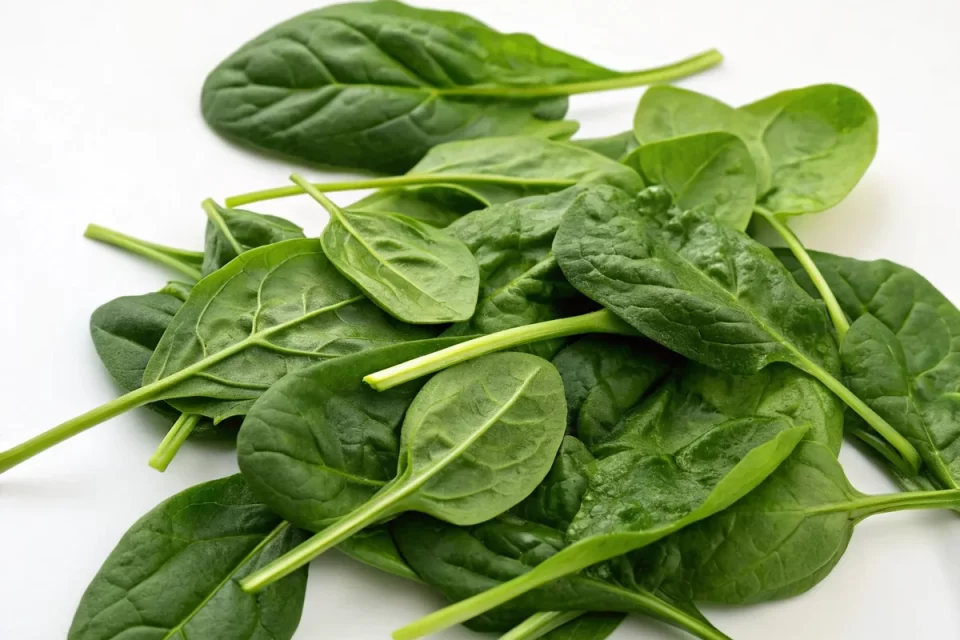Spinach (Spinacia oleracea), a leafy green vegetable, is celebrated for its nutrient density and versatility in global cuisines. Known for its mild flavor and tender texture, spinach enhances both raw and cooked dishes while offering significant health benefits. This article explores spinach’s historical role in food, its nutritional profile, evidence-based health benefits, practical tips for use, and complementary food pairings, supported by scientific research.
History of Spinach in Culinary Traditions
Spinach originated in Persia around 2000 years ago, with records from the 7th century CE documenting its cultivation. It spread to China via trade routes by the 11th century and reached Europe through Moorish Spain in the 12th century. In medieval Europe, spinach was valued for its availability during Lent, often used in soups and stews. By the Renaissance, it appeared in Italian dishes like tortellini and French recipes with cream sauces. In Asia, spinach was stir-fried with garlic or incorporated into Indian saags with spices. Today, spinach is a global staple, featured in Mediterranean salads, American smoothies, and Indian palak paneer, showcasing its adaptability across cuisines.
Nutritional Profile
Spinach is low in calories and packed with vitamins, minerals, and antioxidants. Per 100 grams (approximately 3 cups raw or 1/2 cup cooked):
- Calories: 23 kcal
- Protein: 2.9g
- Fat: 0.4g (0g saturated)
- Carbohydrates: 3.6g (2.2g fiber, 0.4g sugars)
- Vitamins and Minerals:
- Vitamin A: 469µg (52% Daily Value, from beta-carotene)
- Vitamin C: 28.1mg (31% DV)
- Vitamin K: 482.9µg (402% DV)
- Folate: 194µg (49% DV)
- Magnesium: 79mg (19% DV)
- Iron: 2.7mg (15% DV)
- Potassium: 558mg (12% DV)
Spinach contains bioactive compounds like lutein, zeaxanthin, and quercetin, contributing to its health benefits.
Note: Nutritional values are based on USDA data for raw spinach. Cooking may reduce some vitamins (e.g., vitamin C) but increase bioavailability of others (e.g., beta-carotene). Values vary slightly by variety (e.g., baby vs. mature spinach).
Health Benefits
Spinach’s health benefits are driven by its vitamins, minerals, and antioxidants, supported by scientific research. Below are key benefits:
- Eye Health: Lutein and zeaxanthin in spinach protect against age-related macular degeneration. A study in Investigative Ophthalmology & Visual Science (2017) found that dietary lutein from spinach increased macular pigment density, supporting vision health.
- Heart Health: Potassium and nitrates in spinach may lower blood pressure. A meta-analysis in Journal of the American Heart Association (2016) showed that leafy greens like spinach reduced systolic blood pressure by 2–4 mmHg.
- Antioxidant Support: Quercetin and other polyphenols combat oxidative stress. Research in Food Chemistry (2015) demonstrated that spinach extracts reduced free radical damage in cell studies.
- Bone Health: High vitamin K content supports bone mineralization. A study in American Journal of Clinical Nutrition (2001) linked dietary vitamin K from spinach to reduced fracture risk in women.
- Blood Sugar Regulation: Spinach’s fiber and low glycemic index help stabilize blood sugar. A study in Nutrients (2018) found that spinach consumption improved insulin sensitivity in overweight adults.
Note: Oxalates in spinach may inhibit calcium absorption or contribute to kidney stones in susceptible individuals. Those with oxalate-related conditions should consult a healthcare provider. Cooking reduces oxalate content.
Tips for Using Spinach
- Selection: Choose vibrant green leaves with no wilting or yellowing. Baby spinach is milder for salads; mature spinach is better for cooking.
- Storage: Refrigerate unwashed spinach in a perforated plastic bag for up to 5–7 days. Wash just before use to prevent spoilage.
- Preparation: Rinse thoroughly to remove dirt. Steam or sauté lightly to preserve nutrients; overcooking may reduce vitamin C and folate.
- Cooking: Use raw in salads or smoothies, or cook briefly (1–2 minutes) to reduce oxalates and enhance beta-carotene absorption.
- Oxalate Reduction: Blanch spinach for 1 minute and rinse with cold water to lower oxalate content for those concerned about kidney stones.
- Versatility: Blend into smoothies, layer in lasagnas, or wilt into soups for nutrient boosts without overpowering flavors.
Food Pairings for Spinach
Spinach’s mild flavor pairs well with a variety of ingredients, enhancing both taste and nutrition. Below are five healthy combinations:
- Spinach + Avocado + Lemon: Toss raw spinach with avocado slices and a lemon vinaigrette for a nutrient-dense salad rich in healthy fats and vitamin C.
- Spinach + Chickpeas + Garlic: Sauté spinach with chickpeas and garlic for a fiber- and protein-packed dish with iron and antioxidants.
- Spinach + Strawberries + Almonds: Combine raw spinach with strawberries and sliced almonds for a salad high in vitamin C, E, and fiber.
- Spinach + Eggs + Tomatoes: Add spinach to scrambled eggs with tomatoes for a protein-rich breakfast high in lycopene and vitamin A.
- Spinach + Quinoa + Feta: Mix wilted spinach with quinoa and a sprinkle of feta for a balanced meal rich in folate and magnesium.
Scientific and Academic Support
Spinach’s benefits are backed by peer-reviewed research:
- Stringham, J. M., et al. (2017). Investigative Ophthalmology & Visual Science: Spinach’s lutein and zeaxanthin for eye health.
- Kapil, V., et al. (2016). Journal of the American Heart Association: Leafy greens’ impact on blood pressure.
- Bondonno, C. P., et al. (2015). Food Chemistry: Antioxidant properties of spinach polyphenols.
- Booth, S. L., et al. (2001). American Journal of Clinical Nutrition: Vitamin K’s role in bone health.
- Augustin, L. S., et al. (2018). Nutrients: Spinach’s effects on insulin sensitivity.
These studies confirm spinach’s potential to support eye, heart, and bone health, though oxalate content and long-term effects require further consideration.

